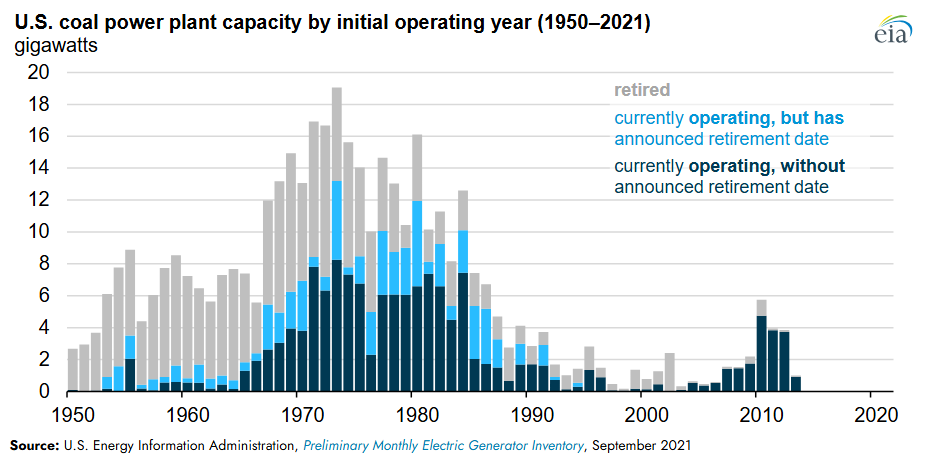𝗜𝘀 𝗰𝗼𝗮𝗹 𝘁𝗵𝗲 𝗸𝗲𝘆 𝘁𝗼 𝗱𝗮𝘁𝗮 𝗰𝗲𝗻𝘁𝗲𝗿 𝗱𝗲𝘃𝗲𝗹𝗼𝗽𝗺𝗲𝗻𝘁?
The Wall Street Journal recently wrote about the 𝗿𝗲𝗱𝗲𝘃𝗲𝗹𝗼𝗽𝗺𝗲𝗻𝘁 𝗼𝗳 𝘁𝗵𝗲 𝗛𝗼𝗺𝗲𝗿 𝗖𝗶𝘁𝘆 𝗚𝗲𝗻𝗲𝗿𝗮𝘁𝗶𝗻𝗴 𝗦𝘁𝗮𝘁𝗶𝗼𝗻 𝗶𝗻𝘁𝗼 𝗮 𝗱𝗮𝘁𝗮 𝗰𝗲𝗻𝘁𝗲𝗿 𝗰𝗮𝗺𝗽𝘂𝘀, complete with up to 4.5 GW of new gas fired generation (turbines from GE Vernova).
Coal power sites have many attractive attributes for data center siting - 𝗲𝘅𝗶𝘀𝘁𝗶𝗻𝗴 𝗲𝗹𝗲𝗰𝘁𝗿𝗶𝗰𝗮𝗹 𝗶𝗻𝗳𝗿𝗮𝘀𝘁𝗿𝘂𝗰𝘁𝘂𝗿𝗲, 𝗹𝗮𝗻𝗱 𝗮𝘃𝗮𝗶𝗹𝗮𝗯𝗶𝗹𝗶𝘁𝘆, 𝗮𝗻𝗱 𝗰𝗼𝗼𝗹𝗶𝗻𝗴 𝗿𝗲𝘀𝗼𝘂𝗿𝗰𝗲𝘀 - and make retiring coal plants a attractive target for redevelopment.
With the bulk of the US coal fired fleet built before 1990, many plants are approaching retirement age (see chart below), and potentially making their sites available for data center development.
The timing is excellent and 𝗮𝗹𝗺𝗼𝘀𝘁 𝗽𝗲𝗿𝗳𝗲𝗰𝘁𝗹𝘆 𝗼𝘃𝗲𝗿𝗹𝗮𝗽𝘀 𝘄𝗶𝘁𝗵 𝘁𝗵𝗲 𝗮𝗰𝗰𝗲𝗹𝗲𝗿𝗮𝘁𝗶𝗼𝗻 𝗶𝗻 𝗱𝗮𝘁𝗮 𝗰𝗲𝗻𝘁𝗲𝗿 𝗱𝗲𝘃𝗲𝗹𝗼𝗽𝗺𝗲𝗻𝘁 𝗮𝗻𝗱 𝗯𝘂𝗶𝗹𝗱 𝗼𝘂𝘁. And 𝘁𝗵𝗲 𝗰𝗮𝗽𝗮𝗰𝗶𝘁𝘆 𝗼𝗳 𝗿𝗲𝘁𝗶𝗿𝗶𝗻𝗴 𝗰𝗼𝗮𝗹 𝗽𝗹𝗮𝗻𝘁𝘀 𝗹𝗶𝗸𝗲𝗹𝘆 𝗲𝘅𝗰𝗲𝗲𝗱𝘀 𝘁𝗵𝗲 𝗽𝗼𝘄𝗲𝗿 𝗰𝗮𝗽𝗮𝗰𝗶𝘁𝘆 𝗱𝗲𝗺𝗮𝗻𝗱𝗲𝗱 𝗯𝘆 𝗻𝗲𝘄 𝗱𝗮𝘁𝗮 𝗰𝗲𝗻𝘁𝗲𝗿 𝘀𝗶𝘁𝗲𝘀. A few examples where this is already happening:
📍𝗪𝗶𝗱𝗼𝘄𝘀 𝗖𝗿𝗲𝗲𝗸 𝗣𝗼𝘄𝗲𝗿 𝗣𝗹𝗮𝗻𝘁 (𝗔𝗹𝗮𝗯𝗮𝗺𝗮): Retired in 2015, acquired by Google for a $600 million renewable-powered data center, operational since 2018 using existing grid and river cooling.
📍𝗠𝗶𝘁𝗰𝗵𝗲𝗹𝗹 𝗣𝗼𝘄𝗲𝗿 𝗣𝗹𝗮𝗻𝘁 (𝗪𝗲𝘀𝘁 𝗩𝗶𝗿𝗴𝗶𝗻𝗶𝗮): Closed in 2015, sold to Digital Realty in 2022 for a hyperscale data center campus, leveraging 1,200 acres and grid infrastructure, in early development as of 2025.
📍𝗛𝗮𝗺𝗺𝗼𝗻𝗱 𝗣𝗼𝘄𝗲𝗿 𝗦𝘁𝗮𝘁𝗶𝗼𝗻 (𝗚𝗲𝗼𝗿𝗴𝗶𝗮): Shut down in 2019, partnered with Switch in 2023 for a $1.2 billion, 500-megawatt data center, construction underway for a 2027 launch near Atlanta.
📍𝗦𝗼𝗺𝗲𝗿𝘀𝗲𝘁 𝗢𝗽𝗲𝗿𝗮𝘁𝗶𝗻𝗴 𝗖𝗼𝗺𝗽𝗮𝗻𝘆 𝗣𝗹𝗮𝗻𝘁 (𝗡𝗲𝘄 𝗬𝗼𝗿𝗸): Decommissioned in 2020, planned for a $300 million, 200-megawatt data center by CBRE, in permitting phase as of 2025 alongside mixed-use redevelopment.
📍𝗣𝗹𝗲𝗮𝘀𝗮𝗻𝘁𝘀 𝗣𝗼𝘄𝗲𝗿 𝗦𝘁𝗮𝘁𝗶𝗼𝗻 (𝗪𝗲𝘀𝘁 𝗩𝗶𝗿𝗴𝗶𝗻𝗶𝗮): Idled in 2023, bought by Fortress in 2024 for a $2 billion, 1-gigawatt data center campus with natural gas power, construction started in 2025, targeting 2028 completion.
Of course retiring coal capacity will need to be replaced with other sources, and data center demand represents net new demand that also requires additional capacity. But that is also where 𝘁𝗵𝗲 𝗛𝗼𝗺𝗲𝗿 𝗖𝗶𝘁𝘆 𝗲𝘅𝗮𝗺𝗽𝗹𝗲 𝗶𝘀 𝗶𝗻𝘀𝘁𝗿𝘂𝗰𝘁𝗶𝘃𝗲: 𝘁𝗵𝗲 𝗿𝗲𝗱𝗲𝘃𝗲𝗹𝗼𝗽𝗺𝗲𝗻𝘁 𝗺𝗼𝗿𝗲 𝘁𝗵𝗮𝗻 𝗱𝗼𝘂𝗯𝗹𝗲𝘀 𝘁𝗵𝗲 𝗰𝗼𝗮𝗹 𝗳𝗮𝗰𝗶𝗹𝗶𝘁𝗶𝗲𝘀 𝗴𝗲𝗻𝗲𝗿𝗮𝘁𝗶𝗻𝗴 𝗰𝗮𝗽𝗮𝗰𝗶𝘁𝘆.
𝗛𝗼𝘄 𝗯𝗶𝗴 𝗮 𝗿𝗼𝗹𝗲 𝗱𝗼 𝘆𝗼𝘂 𝘀𝗲𝗲 𝗳𝗼𝗿 𝗿𝗲𝘁𝗶𝗿𝗲𝗱 𝗰𝗼𝗮𝗹 𝗽𝗹𝗮𝗻𝘁𝘀 𝗶𝗻 𝗺𝗲𝗲𝘁𝗶𝗻𝗴 𝘁𝗵𝗲 𝗱𝗲𝗺𝗮𝗻𝗱 𝗳𝗼𝗿 𝗻𝗲𝘄 𝗱𝗮𝘁𝗮 𝗰𝗲𝗻𝘁𝗲𝗿 𝘀𝗶𝘁𝗲𝘀? 𝗪𝗶𝗹𝗹 𝘁𝗵𝗶𝘀 𝗼𝗽𝘁𝗶𝗼𝗻 𝗽𝗹𝗮𝘆 𝗮 𝗺𝗶𝗻𝗼𝗿 𝗿𝗼𝗹𝗲 𝗮𝗺𝗼𝗻𝗴𝘀𝘁 𝗺𝗮𝗻𝘆 𝗼𝗽𝘁𝗶𝗼𝗻𝘀, 𝗼𝗿 𝗯𝗲𝗰𝗼𝗺𝗲 𝗮 𝗽𝗿𝗲𝗳𝗲𝗿𝗿𝗲𝗱 𝗼𝗽𝘁𝗶𝗼𝗻?



What's not to like?